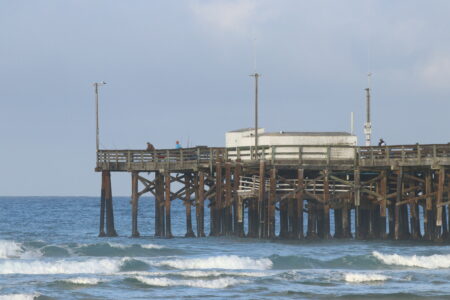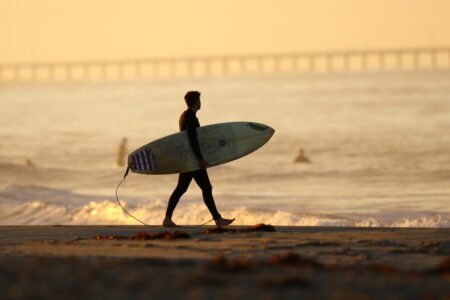The pandemic has given our tech-driven lives a new meaning as people start realizing the outside world isn’t so bad. Public park usage during the quarantine went up by 63.4%, according to PLOS One. People are taking to the outdoors to find some joy through such a hard time.

In our beautiful state of California, especially here in Orange County, we are lucky to have such unique beaches to seek comfort during times of need. The 42-mile Orange County Coastline can be a great place to have a family day, do some activity, or simply relax and take in the sights. Although lifeguards are on duty from 10 a.m. to 6 p.m. during the summer months and 9 a.m. to dusk in the most populated areas, it is still important for everyone to educate themselves on what to do in case of an emergency in order to keep themself and everyone around them safe.
A 2016 survey carried out by UCLA at 11 beaches in SoCal revealed that besides enjoying the scenery and letting the kids play, most people were at the beach to get in the water and go for a swim. For frequent beach-goers, this isn’t a cause for concern, but the same UCLA survey reveals that 16% of visitors were at the beach for the first time. The sheer energy and movement the ocean holds can be a lot to take in for those not accustomed to the waves and currents. The City of Newport Beach reports a 3.5 times increase in emergency calls during May 2020 compared to May 2019. Since then the attendance numbers continue to increase by 16% every year, creating more opportunities for emergency situations. The pandemic quarantine has created a shift in social behavior, and as more people are utilizing our beaches in search of leisure, the concern about public safety in the unpredictable surf becomes more predominant.

In Newport Beach, waves are formed by heavy winds at sea and as these waves gain speed they crash into the unique sandbar formed roughly 150 feet from the shore. During the summer months, winds tend to be at a low, making for beautiful water and weather conditions with small waves. As the months start to turn to winter, wind speeds sometimes reach up to 30-40 mph. During these months, fast winds bring especially big waves that can turn your day sour quickly. Lifelong Huntington Beach surfer Peter Beliakoff recalls a day during Hurricane Frank of July 2022: “We couldn’t even paddle out to surf, the constant bashing of waves made it impossible.” He tried all he could before returning to the beach defeated.
If you happen to find yourself in a situation where the waves are bigger than you are comfortable with and there is no way back to the beach, it is important to NOT PANIC, remain calm, and try to save as much of your breath as possible by not fighting the waves. Be ready to be put through some violence, then, as the wave loses its grip, you’ll breach the surface where you can catch a quick breath in order to make it through the next wave. Eventually, that set of waves will slow down for enough time for you to get to the beach for safety. Things to look for before going in the water are the flags on the lifeguard towers marked green, yellow, and red respectively to how dangerous the waves are on any given day.
Another natural occurrence that can make a potential risk is called a rip current. Newport Beach Lifeguard Captain Brian O’Rourke labels rip currents as “the leading surf hazard for all beachgoers.” As waves constantly crash on the sandy beach, all that water begins to accumulate in large amounts, and it accumulates more and more water until a lot of water is piled up on shore. The built-up water breaks the natural flow, creating a narrow stream perpendicular to the beach generating a steady flow for hours or even days. To the untrained eye, a rip current can look as harmless as some choppy waters. These spots of choppy waters, sometimes containing loose sand picked up from the beach, are good indicators that there is a rip current present. Not paying attention to one’s surroundings can lead to any innocent beach-goer being “caught in the rip” or being stuck in the flow of water taking them away from the beach.
“I’ve seen it turn dangerous so quickly,” 18-year Newport resident and frequent beach-goer Jim Shubin recalls. For the past 3 years, rip currents have accounted for 65% of lifeguard rescues, or 23,400 of the total 35,540 lifeguard rescues in California State Parks. This is because the victim is often oblivious to the situation, and the water can quickly carry someone out into the open ocean. It is always important to observe your surroundings using landmarks as references; if you notice murky, choppy waters around you and it seems like you are drifting further and further out, the solution is to move parallel to the beach in order to escape the narrow path of water carrying you.

The beach is by no means a scary place, but it can be surprising how quickly a situation can occur and how vital it is to know what to do in case it does arise. The same waves that ragdoll you around one day can ignite new passions of surfing or other wave riding forms that so many fall in love with. It is valuable to go and explore what our unique geography has to offer, but be sure to bring with you the correct tools and info to keep yourself safe.


